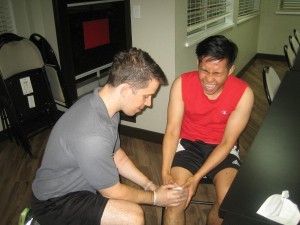A fractured leg, also called a broken leg, occurs when there is a crack  or break in one of the bones of the legs. There are four bones in the leg, which will be discussed in detail later. Fractured legs can either be a simple stress fracture to a compound (open) fracture. Treatment will depend on the bone and intensity of the injury. In extreme cases, surgery may be required for complete healing.
or break in one of the bones of the legs. There are four bones in the leg, which will be discussed in detail later. Fractured legs can either be a simple stress fracture to a compound (open) fracture. Treatment will depend on the bone and intensity of the injury. In extreme cases, surgery may be required for complete healing.
Bones of the Leg
The leg contains four bones and any of these four bones can be fractured. These four bones are the femur, patella, tibia and fibula.
- Femur
- Bone of the thigh
- The longest and strongest bone of the whole body
- Hip joint consists of upper part of femur fitting into the pelvis
- Broken hip pertains to broken upper part of upper part of femur
- Lower end rests on the tibia
- Patella
- Also called kneecap
- Adds leverage to straighten the leg
- Tibia
- Larger bone of the lower leg
- Weight-bearing bone
- Fibula
- Smallerbone of the lower leg
Causes of Fractured Leg
Although it generally takes a lot of force to break the bones of the leg, especially the femur, there are a number of ways to breaking a leg. Some of the following include:
- Motor vehicular accidents
- Injury from contact sports or hyperextending the legs
- Physical assault, which involves kicking the legs
- Accidental falls (common in children), though rarely fractures the femur
- Overuse that lead to tiny cracks from the repetitive force (often cause stress fracture)
- Osteoporosis, especially older ages
- Child abuse
Symptoms of Fractured Leg
Because it is generally hard to break, a broken femur is typically evident. However, since the other three remaining bones are not as strong, symptoms may not be as obvious, especially those involving stress fractures. However, some of the common signs and symptoms include:
- Intense pain, usually worsened by movement
- Bruising and swelling
- Tenderness
- Leg deformity:
- Shortening: unaffected leg seems longer
- Rotation: twisted appearance below the leg
- Angulation: leg is bent at the break
- Inability to walk
- In toddlers who may not be able to explain, they may complain of unexplainable pain and stop walking, usually accompanied by crying.
First Aid Management for Fractured Leg
Call for emergency medical services immediately if one is suspected of fractured leg. Treatment will vary on the type of fracture but the common procedure is:
- If there is bleeding, place a clean, dry cloth on the wound and apply direct pressure until the bleeding stops.
- Do not move the affected leg. If one is trained to apply a splint, do so.
- Rest to avoid exacerbating the injury.
- Apply an ice pack wrapped in towel to reduce swelling.
- Do not attempt to move back the bone to its original position.
- Often, surgery will be required to allow for complete healing. Thus, avoid eating or drinking until doctor gives a go signal.
Disclaimer: This article is for information purposes only and not meant to substitute for medical advice or formal training. To learn how to manage fractured legs and other broken bones in the body, enroll in First Aid Training.
